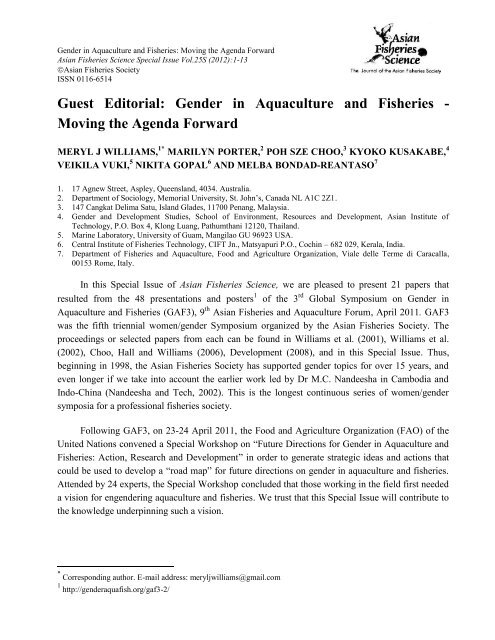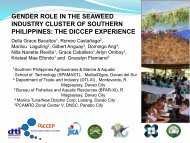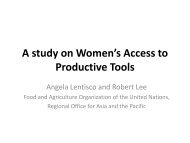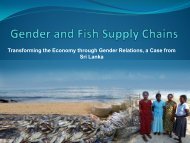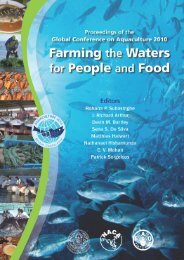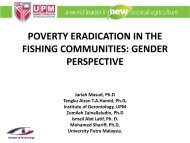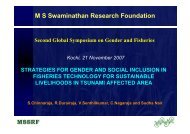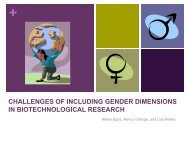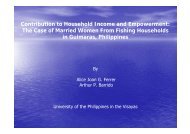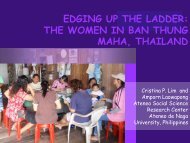Moving the Agenda Forward - GENDER IN AQUACULTURE AND ...
Moving the Agenda Forward - GENDER IN AQUACULTURE AND ...
Moving the Agenda Forward - GENDER IN AQUACULTURE AND ...
Create successful ePaper yourself
Turn your PDF publications into a flip-book with our unique Google optimized e-Paper software.
2Asian Fisheries Science Special Issue Vol.25S (2012):1-13Yet, along with <strong>the</strong> pleasure of introducing this Special Issue, we feel a mix of optimism andpessimism - pleasure because of <strong>the</strong> breadth and depth of <strong>the</strong> knowledge contained in <strong>the</strong> papers,optimism because of emerging interest in gender in aquaculture and fisheries, and pessimismbecause we feel that gender in aquaculture and fisheries research has not progressed as strongly oras rapidly as it should. Despite <strong>the</strong> evidence that women play large, though undervalued, andfunctionally critical roles in fish supply chains, <strong>the</strong> slow progress in advancement of women reflectsa global lack of priority and resources, evident also in Asia, to women and gender issues inaquaculture and fisheries.Let us first explain <strong>the</strong> causes of our pessimism and optimism through three observationsbefore turning to an outline of <strong>the</strong> papers.First, we observe that women and gender topics are “not on <strong>the</strong> agenda” in aquaculture andfisheries. Research and action receives very little support from governments, universities andexternal funders such as development donors and non-government organizations. In Asia, a fewexceptions stand out. One is <strong>the</strong> Mekong River Commission Fisheries Program and its 4 membercountries fisheries departments that, for 12 years, have conducted a Mekong basin-wide Network forPromotion of Gender in Fisheries (NGF) . Ano<strong>the</strong>r exception is <strong>the</strong> International Collective inSupport of Fishworkers (ICSF) which has <strong>the</strong> biannual Yemaya newsletter on women in fisheries,takes up women’s issues through its regional partners and recently held a global workshop on <strong>the</strong>gender agenda in fisheries (ICSF, 2010).The lack of attention to women and gender starts in policy-blindness. Women and genderissues are missing from key global normative fisheries (and aquaculture) products such as <strong>the</strong> Codeof Conduct for Responsible Fisheries (FAO, 1995) and many of its succe eding instruments andtechnical guidelines (Williams, 2010). These instruments reveal how aquaculture and fisheries arepresently framed, and hence <strong>the</strong> priority issues addressed – gender is not visible. O<strong>the</strong>r humandimensions are similarly lightly treated. Technical production, market driven and environmentalissues predominate, such as illegal fishing, aquaculture production and product certification, and <strong>the</strong>ecosystem approach to fisheries. Even where <strong>the</strong>se areas of focus would be expected to encompasssignificant gender and o<strong>the</strong>r human dimensions, <strong>the</strong>y rarely do. A turning point may have beenreached, however, as <strong>the</strong> 2010 Global Conference on Aquaculture, conducted by FAO, <strong>the</strong> Networkof Aquaculture Centers in Asia and <strong>the</strong> Thailand Department of Fisheries, included a gender andhuman capacity development segment (Williams et al. 2012).Without focus and resources, progress is difficult and slow. Many of <strong>the</strong> authors in thisSpecial Issue are conducting gender studies as a sideline to <strong>the</strong>ir main fields of work and some haveentered <strong>the</strong> field as non-specialists who have realized <strong>the</strong> need, in <strong>the</strong> course of o<strong>the</strong>r studies.
Asian Fisheries Science Special Issue Vol.25S (2012):1-13 3We have also witnessed <strong>the</strong> phenomenon of women and gender specialists in social scienceresearch departments moving on from studying aquaculture and fisheries to studies in o<strong>the</strong>r sectorsor overarching <strong>the</strong>mes such as climate change and women’s mobility. Some among us are part ofthis shift. In order to flourish, any field of research and education needs resources – researchers,funds, students. Like o<strong>the</strong>r researchers, women and gender researchers and students “follow <strong>the</strong>money.” Because gender and fish sector funding is minimal, some of <strong>the</strong> most significantresearchers in <strong>the</strong> field have moved on to study gender in o<strong>the</strong>r fields.To compound <strong>the</strong> problem of low support, many researchers and activists have beendisheartened because <strong>the</strong>ir advice was rarely sought, or accepted and used when given. For example,inshore fishers, and especially women, warned that <strong>the</strong> North Atlantic cod stocks were in declineyears ahead of Canadian government recognition of <strong>the</strong> crisis (Neis, 2000, Grzetic, 2004).Development assistance agencies often fund research and <strong>the</strong>n <strong>the</strong>y use <strong>the</strong> results to inform<strong>the</strong>ir actions or set new programme directions. Few aquaculture and fisheries projects, however,have gender components and hence development assistance agencies are providing little support toresearch in gender in aquaculture and fisheries. A current exception is <strong>the</strong> FAO-Spain RegionalFisheries Livelihoods Programme (see papers by Lentisco and Arenas, Nguyen Dang Hao andSegundia et al. in <strong>the</strong> current Special Issue).The lack of attention to gender in fish sector projects could be partly compensated byborrowing from gender work in o<strong>the</strong>r rural sectors. The quantum of gender and agriculture workseems to be increasing since FAO highlighted <strong>the</strong> “gender gap in agriculture” in its State of Foodand Agriculture report (FAO, 2011). The report also touched lightly on aquaculture and fisheries.Following this report, more attention to women in agriculture is evident among <strong>the</strong> multi-lateraldevelopment agencies such as FAO, <strong>the</strong> International Fund for Agricultural Development ( IFAD)and <strong>the</strong> World Bank. Several new electronic platforms have been created to promote gender andagriculture research and action, and o<strong>the</strong>r significant development actors have distilled practicallessons learned from helping women, e.g., Anonymous (2012). In March 2012, <strong>the</strong> Indian Councilfor Agricultural Research and several international professional bodies sponsored <strong>the</strong> first GlobalConference on Women in Agriculture. Agriculture researchers are addressing land rights issues forwomen, measuring women’s empowerment and assets and mapping women’s activities. The fishsector was acknowledged to some extent in <strong>the</strong> 2012 Global Conference on Women in Agriculture.We cannot take for granted that this flurry of attention to women in agriculture will alsostimulate more research and action on aquaculture and fisheries. It is, however, a positivedevelopment that should be harnessed. Choo et al. (2008) pointed out that fisheries and aquacultureare influenced ultimately by global trends in development. So far, no large scale quantitative studyon gender and fisheries has been conducted in any part of <strong>the</strong> world, unlike on gender andagriculture.
4Asian Fisheries Science Special Issue Vol.25S (2012):1-13As we write, o<strong>the</strong>r signs of optimism closer to aquaculture and fisheries include that severalmainstream institutions are beginning to include gender work and strategies in <strong>the</strong>ir programs. Forexample, The CGIAR recently adopted a new research program on aquatic agricultural systems. Theprogram focuses squarely on food security and integrated livelihood for <strong>the</strong> poor. It is an innovativeand ambitious research program that has strong focus on gender mainstreaming, as can be seen from<strong>the</strong> fact that one of <strong>the</strong> six research <strong>the</strong>mes is on gender equity. Noting that <strong>the</strong> total requestedbudget for <strong>the</strong> program is US$59.4 million with projected partner funding of US$300 million over athree years period, it may provide substantial resources for advancing gender and fisheries research.What is important to note is that such strong gender focus is possible because <strong>the</strong> program movedaway from component crops and fisheries and focused on integrated livelihood systems. By lookingat <strong>the</strong> system that women and men are working/living in, ra<strong>the</strong>r than looking only at fish, <strong>the</strong>re isgreater opportunity to address <strong>the</strong> issues of gender equity as well as o<strong>the</strong>r social issues.Fur<strong>the</strong>r optimism comes from <strong>the</strong> rising interest in value chains in fisheries research. Justbecause few women go out in large boats to fish, <strong>the</strong>y are often not considered fishers andmarginalized in fisheries sector analysis, as many of <strong>the</strong> papers in this volume pointed out. Thefocus on value chains puts a new light on women’s role in aquaculture and fisheries, and highlights<strong>the</strong> importance of post harvest activities such as trade and processing. This is becoming all <strong>the</strong> moreimportant because of <strong>the</strong> regional economic integration, such as in <strong>the</strong> ASEAN region.Our second observation is that women/gender studies in aquaculture and fisheries are notmonolithic and <strong>the</strong>y will not be addressed by a single discipline or epistemology. Thismethodological plurality contrasts with <strong>the</strong> case in technical fields such as fish diseases, stockassessment, hatchery technology and safety at sea. Indeed, considerable differences of opinionprevail over gender research, and even whe<strong>the</strong>r “gender” approaches are weakening attention to <strong>the</strong>very urgent problems that many women, especially poor women, experience in <strong>the</strong> fish sector, e.g.,Biswas (2011).One of <strong>the</strong> problems of advancing <strong>the</strong> gender and fisheries/ aquaculture field is <strong>the</strong> difficultyin conducting truly multi-disciplinary research. Fisheries biologists realize that <strong>the</strong>y need tounderstand about <strong>the</strong> people who are engaged in fish production, hence focus more on genderdivision of labor in fish production. Social scientists are concerned with social relations andstructures as well as livelihood systems but often lack knowledge of fisheries/aquaculture systemsand technologies and fish species that people are engaged with. In order to advance <strong>the</strong> field, weneed to combine both perspectives. For example, <strong>the</strong> following questions can only be answeredthrough work by multi-disciplinary teams.- With increased demand for water for agriculture/industries/tourism/fisheries, how much waterwould be available for fisheries and aquaculture? How much would fisherwomen be able tonegotiate for water for <strong>the</strong>ir own production, giving <strong>the</strong>ir weak negotiating power and low
Asian Fisheries Science Special Issue Vol.25S (2012):1-13 5visibility in <strong>the</strong> sector? How would that affect <strong>the</strong> fish availability for fishing/fish culturehouseholds? What are alternative livelihoods or possibilities of upgrading women and men’spresent positions in aquaculture and fisheries?- How would fish production technology help in improving food security? For whom? Why?- With cross-border trade facilitated, what are <strong>the</strong> implications for food security for <strong>the</strong> poor?How would aquaculture and fisheries play a role in food security for <strong>the</strong> women and men inpoor households? How can poor women maintain access to fisheries resources for <strong>the</strong>ir foodsecurity? How can women retain or gain access to fish for processing and sale against o<strong>the</strong>rcompetitive buyers?Ano<strong>the</strong>r problem of gender and fisheries research is that when we look at only <strong>the</strong> genderdivision of labor, we often cannot deny that women are playing a marginal role vis-à-vis men.However, when we look at <strong>the</strong> dimension of household food security and livelihood, we find thatwomen contribute as much and sometimes more than men. What are <strong>the</strong> species available forwomen to catch and trade, or to be consumed at home? What are <strong>the</strong> aquatic resources available forpoor women for processing and trade? What are <strong>the</strong> technologies available for <strong>the</strong>m? Whatbargaining power do women have in <strong>the</strong> value chain, including rights to exploit fisheries resources?Gender and fisheries needs to take a more systems approach in order to reveal <strong>the</strong> gender relationsand problems that women face in fisheries. To do so requires collaboration between social scienceand fisheries biologists.Compared to fisheries, gender and aquaculture needs a totally different framework of analysis.The issues for gender and aquaculture are more similar to issues in gender and agriculture or genderand enterprise development. Hence, basic gender analysis concepts such as gender division of laborand access/control over resources provide us considerable insights into <strong>the</strong> gender issues in genderand aquaculture. IFPRI toge<strong>the</strong>r with USAID and <strong>the</strong> Oxford Poverty and Human DevelopmentInitiative (OPHI) has developed a women’s empowerment index in agriculture (IFPRI et al 2012);gender and aquaculture can learn much from <strong>the</strong>m. In terms of methods, <strong>the</strong> IFPRI researchersconducted a questionnaire survey for both wives and husbands in households, allowing betterinsights into <strong>the</strong> intra-household gender relations in farming, and to some extent in fisheries.Thus, looking at fisheries as a system and aquaculture as a household economic productionactivity, existing methodologies can be expanded into <strong>the</strong> field of gender in aquaculture andfisheries.We need to integrate and build on <strong>the</strong> skills and knowledge of both <strong>the</strong> fisheries scientists and<strong>the</strong> social scientists if we are to address <strong>the</strong> problems confronting <strong>the</strong> fish sector. We need toinvestigate, in depth, <strong>the</strong> complex relationships among resources and environmental sustainability,and <strong>the</strong> conditions of harvesting and processing fish resources and <strong>the</strong> social and cultural context inwhich fishing and fish processing takes place.
6Asian Fisheries Science Special Issue Vol.25S (2012):1-13Each fish production system has its own needs for research and action. At <strong>the</strong> broadest level,we need to stop simplifying <strong>the</strong> fish production sector by lumping aquaculture and fisheries, and byfailing to take local soci-ecological settings into account within each type of production system.This leads to our third observation which is that: much work is needed to develop anddisseminate better conceptual frameworks for studies on gender in aquaculture and fisheries.Building <strong>the</strong> new foundations requires <strong>the</strong> engagement of <strong>the</strong> more academic researchers andactivists who have been engaged in Asian Fisheries Society symposia, and more besides <strong>the</strong>se. Untilmore financial and institutional support is available to this field of research, progress will continueto be modest.Experience has shown that women/gender issues are invisible to many in <strong>the</strong> fish sector andadvocacy is required to raise <strong>the</strong> profile of gender. Credible, dedicated and persistent champions areneeded. One initial target of action is to bring about policy changes to engender aquaculture andfisheries because, without this, <strong>the</strong> mandate and platform for gender focus is lacking.Above, we commented that many of those doing gender research are not educated in genderresearch methods. Beyond this small group, most experts in aquaculture and fisheries have nogender education and very little awareness of <strong>the</strong> issues. Gender training, education and extension,<strong>the</strong>refore, are needed to reach a wide spectrum of people in aquaculture and fisheries. Basicconcepts need to be defined, disseminated and understood; gender disaggregated data should beroutinely collected; and research and comparative analysis conducted. With development andbroader use of conceptual frameworks for data collection and research design, cross countrycomparisons would become possible. They are presently impeded by statisticians and researchersusing different approaches. To illustrate <strong>the</strong> demand for more solid foundations, on ourGenderaquafish website, <strong>the</strong> glossary of terms, compiled from authoritative sources, is <strong>the</strong> mostvisited page apart from those dealing with GAF3 (http://genderaquafish.org/resources-3/glossary-ofterms/).In summary, we find that women/gender studies are progressing only slowly in aquacultureand fisheries because <strong>the</strong>y: (1) are not on <strong>the</strong> policy agendas and action plans and <strong>the</strong>refore minimalresources are devoted to <strong>the</strong>m; (2); are not amenable to a single epistemology and different visionscompete; and (3) require stronger conceptual foundations to be developed, disseminated and used.The Special IssueIn terms of topics and study approaches, <strong>the</strong> GAF3 Special Issue papers are heterogeneous.They examine some of <strong>the</strong> major <strong>the</strong>mes of gender in aquaculture and fisheries, using differentdisciplines including sociology, political science, geography, economics, anthropology, ruraldevelopment and supply chain analysis.
8Asian Fisheries Science Special Issue Vol.25S (2012):1-13The fisheries papers of this Special Issue analyse many different ways in which women andmen participate in <strong>the</strong> harvesting sector. While women are still a very small proportion of harvesters,particularly in offshore fisheries, <strong>the</strong>ir contribution is vital, especially in <strong>the</strong> small scale inshorefisheries and in small communities. Two papers address overarching issues. Marilyn Porter makes<strong>the</strong> sociological argument that policy is often directed narrowly at improving fish harvesting andprocessing, without taking account of its impact on women, families and <strong>the</strong> community, drawing ondata from <strong>the</strong> contrasting situations in coastal Tanzania and Atlantic Canada. She argues thatstudying coastal communities through a gender lens would have greater impact if <strong>the</strong> research couldbe commonly framed and attention paid especially to power, inequality and discrimination and howwomen manage to negotiate better positions for <strong>the</strong>mselves and <strong>the</strong>ir families. Holly Hapke’s paperuses feminist commodity chain analysis, livelihoods analysis, and insights from feminist studies ofgender and development to examine different impacts of globalization rooted in gender divisions oflabour, taking her examples from Kerala, India.Two papers deal with <strong>the</strong> unique practices and experiences of women who free dive for shellfish, seaweed, sea urchin, lobster, sea cucumber, oyster, octopus and abalone in Japan and Korea.Cristina Lim and her colleagues contrast <strong>the</strong> skill and high earnings of Japanese women divers with<strong>the</strong>ir low social status. Sun-Ae Li makes similar points about Korean divers, but also traces <strong>the</strong> longand complex history of <strong>the</strong> women divers and accounts for <strong>the</strong> dwindling of <strong>the</strong> occupation. NguyenDang Hao moves our attention to Vietnam, with a detailed account of <strong>the</strong> unequal and inferiorposition of women in fishing communities in central Vietnam. Despite <strong>the</strong>ir longer hours of workand active participation in fish processing and trading, <strong>the</strong>y have higher rates of poverty, lowerlevels of education and are excluded from all <strong>the</strong> significant locations of decision making and socialpower. The education, income and asset patterns across better-off, average and poor householdsshowed that women in average and poor households were <strong>the</strong> most poorly educated and engagedmore in small scale and less remunerative activities, than was <strong>the</strong> case for men. Even in better offhouseholds, women’s activities were less remunerative than men’s.Two papers present women’s role in coastal cities and remote fishing communities inIndonesia. In fishing communities in two coastal cities of Central Java, Zuzy Anna used rapidquantitative appraisal (rapfish) research methods to analyze <strong>the</strong> ecological, economic, social andinstitutional uncertainties challenging women. The most important indicators for <strong>the</strong> differentdimensions of uncertainty were: drought, pollution and season (ecological), uncertain productionand income (economic), high divorce rates, high unemployment and poor health (social) and highdependency on credit and local financiers (institution). The women cope with <strong>the</strong> uncertainties bycontrolling spending and by taking part-time employment outside <strong>the</strong> home. In <strong>the</strong> remote Pantarislands of Indonesia, women were not as highly regarded as men as users of marine resources. RiaFitirana and Natasha Stacey used participatory rural appraisal and focus groups discussions toanalyze <strong>the</strong> gender dimension related to fishing activities throughout <strong>the</strong> supply chain.
Asian Fisheries Science Special Issue Vol.25S (2012):1-13 9Fishing activities included a wide range but some women and men’s activities overlap. Yet,<strong>the</strong> women of <strong>the</strong> Pantar fishery ran <strong>the</strong> real risk of not being included as key stakeholders inconsultations over <strong>the</strong> local emerging marine conservation plans under <strong>the</strong> Coral Triangle Initiative.Xijie Xu and colleagues’ paper on women’s roles in China’s new inland and coastal fishingvillages emphasizes <strong>the</strong> pivotal roles and opportunities for women in <strong>the</strong> newly constructed villages.Women make up about 60% of <strong>the</strong> labor force and have a heavy work load. Although women’sorganization skills have streng<strong>the</strong>ned <strong>the</strong> construction of new fishing villages, women are stillconsidered marginal and still lack full participation in China’s new economic era.Microfinance has become popular for many vulnerable fishing households in Kerala, India.Microfinance is often given to women without any study undertaken on its impact. In <strong>the</strong>ir paper,Nikita Gopal and colleagues reported that microfinance schemes have supported family finances andhave improved household financial decision-making in poor households. Most of <strong>the</strong> microfinancefunds have supported household expenses and have had very little impact on developingentrepreneurial opportunities for women. The credit has encouraged consumption ra<strong>the</strong>r thanproduction. The study stressed <strong>the</strong> need to fur<strong>the</strong>r examine <strong>the</strong> use of credit as a financingmechanism in poor households.In different ways and drawing on data on women and men from different societies and indifferent socio-ecological settings, all <strong>the</strong>se papers draw attention to <strong>the</strong> significant contribution thatwomen make to fisheries – but also that in all cases women benefit less than men do, carry heavierloads of work and responsibility and have much less access to decision making and resourcemanagement.Generally, <strong>the</strong> role of women in fisheries has been most visible in post harvest activities butthis Special Issue has only one paper focusing just on post-harvest. While <strong>the</strong> physically demandingsea fishing was primarily (though as evidence shows, not exclusively) a male domain, women were<strong>the</strong> main handlers, processors and marketers of fish on shore. This division in labour was observedin <strong>the</strong> study from Philippines by Corazon Macachor and colleagues. The men were involved infishing activity but <strong>the</strong> production of smoked frigate mackerel was predominantly a female preservebased on traditionally acquired knowledge. When it came to marketing, <strong>the</strong> women processors’ areaof operation was limited and <strong>the</strong> far off markets were catered to by men.Women’s agency in fish supply chains and ecosystemsSix papers discuss women’s own agency in aquaculture and fisheries production. All highlight<strong>the</strong> important roles women can or could play in this sector. Importantly, all papers explore howthrough proper intervention, women’s roles can become more visible and <strong>the</strong>ir agency can bestreng<strong>the</strong>ned through <strong>the</strong>ir involvement in aquaculture and fisheries. Three papers discuss differentways involvement in aquaculture and fisheries can benefit women.
10Asian Fisheries Science Special Issue Vol.25S (2012):1-13In Nepal, Sunila Rai and co-authors analyzed how household ponds can lead to increasedconsumption of micro-nutrient rich small indigenous fish species, benefiting nutrition levels ofwomen and children. Rosaria Gaerlan Segundia and co-authors demonstrated how value-added fishproducts can lead to women’s empowerment in <strong>the</strong> Philippines. For Thailand, Cristina Lim andAmporn Laowapong argued that with leadership opportunities and training, women in coastalcommunities can take a greater leadership role through <strong>the</strong>ir involvement in fisheries. Their positionis illustrated by five compelling case studies.The o<strong>the</strong>r three papers explored how organizing women through self-help groups in fisheriescan empower women in <strong>the</strong>ir fisheries related activities. B. Shanthi and her colleagues, bydescribing various cases of women entrepreneurs involved in fish related business, showed that selfhelpgroups as well as better education in general supported <strong>the</strong>ir businesses as well as helped <strong>the</strong>mto achieve higher entrepreneurial skills. However, one catch was that most of <strong>the</strong>se women wereinvolved in traditionally defined women’s activities. Md Ghulam Kibria and Gosbert Hamutenyadescribed a case in Namibia where a women-run aquaculture project, though producing only a smallharvest, has provided women with a place to discuss future plans to improve future yields. FarisalBagsit and Caridad Jimenez, in <strong>the</strong>ir case in <strong>the</strong> Philippines, showed how women call <strong>the</strong>ir work onmangroves “meetings”, and demonstrated excellent feedback mechanism that lead to well-managedmangrove reforestation program. This project was considered to be an exception where most of <strong>the</strong>o<strong>the</strong>r mangrove programs were dominated by men, although <strong>the</strong> women’s group still had difficultyin getting acceptance from <strong>the</strong> community as a whole.Women in aquaculture and fisheries institutionsTwo papers dealt with women in aquaculture and fisheries institutions.The first paper, by Angela Lentisco and Enrique Alonso, on gender mainstreaming strategiesand tools in fisheries development projects gave as an example <strong>the</strong> Spanish-funded RegionalFisheries Livelihoods Programme (R FLP) implemented by FAO which considered gendermainstreaming as an important cross-cutting issue of its implementation. The RFLP is aimed atimproving <strong>the</strong> livelihoods of small-scale coastal communities while contributing to sustainablemanagement of aquatic resources.A set of actions contained within <strong>the</strong> broad <strong>the</strong>me of information ga<strong>the</strong>ring, knowledgesharing, implementation, monitoring and evaluation, and capacity development comprise <strong>the</strong> overallstrategy for gender mainstreaming of <strong>the</strong> RFLP.To support <strong>the</strong> implementation of this gender mainstreaming strategy, a handbook wasdeveloped, presented during a workshop on best practices, and improved prior to publication, takinginto consideration <strong>the</strong> debate on policies, concepts, tools and frameworks for gender analysis, and
Asian Fisheries Science Special Issue Vol.25S (2012):1-13 11including field experiences, case studies and o<strong>the</strong>r strategies towards addressing and integratinggender dimensions in development projects.Key lessons for effective gender mainstreaming in <strong>the</strong> fisheries sector based on RFLPexperience include: (1) <strong>the</strong> need to highlight <strong>the</strong> roles and contribution of women; (2) <strong>the</strong>importance of gender analysis throughout all phases of project development; (3) <strong>the</strong> value of localcontext and <strong>the</strong> skills and knowledge of researchers when applying gender mainstreaming tools; and(4) <strong>the</strong> need for more policy and institutional support from governments and relevant organizations.The second paper, by Hillary Egna and co-authors, on improving gender equity in aquacultureeducation and training was based on 30 years experience under <strong>the</strong> AquaFish CollaborativeResearch Support Programs (CRSP, 2006 to present) and its predecessors, i.e. <strong>the</strong> PondDynamic/Aquaculture (PD/A CRSP, 1982 -1996 and <strong>the</strong> Aquaculture CRSP, 1996-2008). Theseprogrammes were dedicated to improving gender equality in <strong>the</strong> aquaculture and fisheries sectors bycreating equal opportunities for women and men to participate in <strong>the</strong> programmes’ research,training, educational and o<strong>the</strong>r activities – thus creating tools to empower especially women,increase <strong>the</strong>ir bargaining power and enter new career opportunities. A multi-faceted approach wasadopted to promote and integrate gender equality through specific actions including: (1) collectionand analysis of disaggregated data; (2) setting a 50% benchmark for women’s participation in bothformal and informal training opportunities; (3) requiring a gender strategy for all core researchprojects; (4) ensuring at least one gender-focused investigation in all of <strong>the</strong> core research projects;and (5) providing extension and technical services directed at women in sustainable aquaculture andaquatic resource management.While great strides have been made recently in terms of equal rights, educational andprofessional opportunities, better wages and political power for more women in <strong>the</strong> formal sector,statistics from AquaFish showed characteristics of a “leaky pipeline”. The paper makes recommendations tohelp overcome this phenomenon in <strong>the</strong> programme.ConclusionsAlthough <strong>the</strong> field of gender in aquaculture and fisheries is still under-researched and underfunded,an increasing number of people and institutions are interested in it, as can be seen by <strong>the</strong>number of papers submitted to <strong>the</strong> 3 rd GAF symposium, and <strong>the</strong> number of papers in this SpecialIssue. As presently comprised, GAF researchers form a loose network comprised of biologists aswell as social scientists from several disciplines, placing interested parties in a good position tocoordinate innovative research with a multi-disciplinary approach. The collection of papers in thisvolume shows that we have become quite successful in visualizing women’s contribution tofisheries and aquaculture. We have also been able to come up with more structural analysis bylooking at value chains and institutions, dealing squarely with <strong>the</strong> relations of women infisheries/aquaculture with o<strong>the</strong>r actors. The field is now faced with more challenges with climate
12Asian Fisheries Science Special Issue Vol.25S (2012):1-13change and economic integration, which would require us to do a more nuanced analysis ondifferent contexts and ecological/economical/political/cultural systems.We also need to highlight <strong>the</strong> issues of inter-sectionality – <strong>the</strong> axis of analysis is not onlyabout women and men, but how <strong>the</strong> o<strong>the</strong>r factors such as class, age, ethnicity, race, caste, religionetc all come into play to define/condition <strong>the</strong> relations that one would have in <strong>the</strong>fisheries/aquaculture systems. We hope that in <strong>the</strong> near future, we will be able to report veryoptimistically on progress in gender in aquaculture and fisheries research and development.ReferencesAnonymous. 2012. What works for women? Proven approaches for empowering women smallholders and achievingfood security. Actionaid, Care, Christian Aid, Concern Worldwide, Find Your Feet, Oxfam, Practical Action,Save <strong>the</strong> Children, Self Help Africa, London. 19 pp.Biswas, N. 2011. Turning <strong>the</strong> tide: women’s lives in fisheries and <strong>the</strong> assault of capital. Economic and Political Weekly.XLVI:53-60.Choo, P.S., S.J. Hall, and M.J. Williams (eds.). 2006. Global symposium on gender and fisheries. Seventh AsianFisheries Forum, 1–2 December 2004. WorldFish Center and Asian Fisheries Society, Penang. 174 pp.FAO (Food and Agricultural Organization). 1995. Code of conduct for responsible fisheries. FAO, Rome. 41 pp.FAO. 2011. State of food and agriculture 2010-2011: women in agriculture closing <strong>the</strong> gender gap for development.FAO, Rome. 145 pp.Development. 2008. Gender and fisheries. 51(2) (several papers and articles).Grzetic, Brenda. 2004. Women Fishes These Days. Fernwood Publishing, Halifax. 128 pp.ICSF (International Collective in Support of Fishworkers). 2010. Recasting <strong>the</strong> net: defining a gender agenda forsustaining life and livelihoods in fishing communities. Report of workshop 7-10 July 2010, Mahabalipuram,India. ICSF, Chennai 87 pp.Nandeesha, M.C. and E. Tech. 2002. Women in fisheries activities of <strong>the</strong> Asian Fisheries Society – have <strong>the</strong>y been ableto make an impact? In: Global symposium on women in fisheries: Sixth Asian Fisheries Forum. 29 November2001, Kaohsiung, Taiwan. (ed. M.J. Williams, N.H. Chao, P.S. Choo, K. Matics, M.C.N. Nandeesha, M. Shariff,E. Tech, and J.M.C. Wong), pp 8-12. World Fish Centre and Asian Fisheries Society, Penang.Neis, Barbara. 2000. In <strong>the</strong> eye of <strong>the</strong> storm: research, activism and teaching within <strong>the</strong> Newfoundland fishery crisis.Women’s Studies International Forum. 23:287-298.Ostrom, E. 2009. A general framework for analyzing sustainability of social-ecological systems Science 325:419-422.Williams, M. 2010. Gender dimensions in fisheries management. In: Handbook of marine fisheries conservation andmanagement (ed. R.Q. Grafton, R. Hilborn, D. Squires, M. Tait and M. Williams), pp. 72-86. Oxford UniversityPress, New York.Williams, M.J., M.C. Nandeesha, V.P. Corral, E. Tech, and P.S. Choo (eds.). 2001. International symposium on womenin Asian fisheries: Fifth Asian Fisheries Forum. Asian Fisheries Society, 13 November 1998, Chiang Mai,Thailand. WorldFish Center and Asian Fisheries Society, Penang. 181 pp.
Asian Fisheries Science Special Issue Vol.25S (2012):1-13 13Williams, M.J, N.H. Chao, P.S. Choo, K. Matics, M.C.N. Nandeesha, M. Shariff, E. Tech, and J.M.C. Wong (eds).2002. Global symposium on women in fisheries: Sixth Asian Fisheries Forum. 29 November 2001, Kaohsiung,Taiwan. World Fish Centre and Asian Fisheries Society, Penang. 201 pp.Williams, M.J., R. Agbayani, R. Bhujel, M.G. Bondad-Reantaso, C. Brugere, P.S. Choo, J. Dhont, A. Galmiche-Tejeda,K. Ghulam, K. Kusakabe, D. Little, M.C. Nandeesha, P. Sorgeloos, N. Weeratunge, S. Williams and P. Xu. 2012.Expert panel review 6.3: sustaining aquaculture by developing human capacity and enhancing opportunities forwomen. In: Proceedings of <strong>the</strong> Global Conference on Aquaculture 2010: farming <strong>the</strong> waters for people and food.(eds. R.P. Subasinghe, J.R. Arthur, D.M. Bartley, S.S. De Silva, M. Halwart, N. Hishamunda, C. V. Mohan andP. Sorgeloos). pp. 785-922. FAO, Rome and Network of Aquaculture Centers in Asia, Bangkok.


